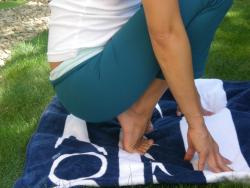Yoga for Swimmers
Tips for coaching your swimmers to overall health
We have all heard it a hundred times …Yoga is good for you. Whether you are young or old, a world-class athlete or a couch potato, the physical and mental benefits of yoga can help anyone with just about anything. OK, but let’s get specific. How can it benefit your swimmers? And, how can you seamlessly incorporate into your workout to help your swimmers feel better and prevent injury?
Why Yoga is Good for Swimmers
As any coach knows, swimming is a great low impact workout, but if an athlete just swims, without doing counteracting physical activity, the body can become misaligned. For example, swimmers generally have overdeveloped their front bodies (backstrokers may suffer from this less) with strong pectorals. This causes the muscles on the back of the body, specifically those that hold the rhomboids or shoulder blades in place, to become relatively weak. This creates the typical hunched-back swimmers’ posture that we are all familiar with. Yoga creates muscles that are extended and long, rather than compacted or contracted. It can also be used to strengthen weaker opposing muscles that are not used in the repetitive motions in swimming.
How to Incorporate Yoga into Your Workout
I will focus on two important areas of the body for swimmers: the shoulders and the feet/ankles. The yoga postures below can help improve your swimmers’ technique and prevent injury. All poses should be done with a steady mind and smooth inhale and exhale through the nose, mouth closed.
Shoulders
Swimmers should learn to keep their shoulders moving back and down the back of the body using the muscle back muscles. This holds the shoulder in correct position during the swim stroke. When the muscles are not accustomed to doing this, the tendon bears much of the weight of the arm, resulting in an injured shoulder. To strengthen these small muscles of the back, do this simple stretch with correct shoulder alignment:
Pose: Reverse Namaste Arms
Seated in kneeling, with the hips on the heels, draw your arms straight out to the sides and then palms together behind your back with your fingers pointing down. Then turn your hands so your fingers go in toward you and then up your back so they are pointing toward the sky. Move your hands up the back, pressing your palms together. Roll your shoulders up back and down and spread the chest open. Make sure the elbows are moving back. You can also hold onto the elbows or forearms if less flexible. Hold for 5 or more smooth, steady breaths.
Feet/Ankles
Strong, flexible feet and ankles are an important tool for any swimmer. They drive the body forward with a strong kick. If the ankles and feet are tight, the kick is compromised and can literally pull you backward. These stretches will create strength and flexibility in your swimmers’ feet and ankles, which will help them streamline into the water effectively and propel themselves with an efficient kick.
 Pose: Foot Stretch a) and b)
Pose: Foot Stretch a) and b)
a) Come to a squat position resting on the balls of your feet and the tips of your fingers. Keep your hips low, your chest open and move your heels up and down, stretching the arches and the balls or your feet, creating a deep crease at the base of your toes. Repeat as comfortable.
 b) Now sit back on your heels, in a kneeling position and curl your toes under, lift your knees up and down to stretch the front of the foot and ankle. Keep you shoulders over your hips as much as possible. Repeat as comfortable.
b) Now sit back on your heels, in a kneeling position and curl your toes under, lift your knees up and down to stretch the front of the foot and ankle. Keep you shoulders over your hips as much as possible. Repeat as comfortable.
Tips to Take Away:
- Even doing 5 minutes of these stretches with correct alignment, steady focus and breathing, is Yoga! You can incorporate these simple moves during a team stretch at the beginning of each workout or encourage your athletes to stay for five minutes after practice to stretch out the set you’ve just given them.
- Done consistently, yoga helps prevent injury and improve both physical and mental performance in your swimmers. You can not only help your athletes stay fit, but you can help them stay injury free. Many Masters swimmers don’t just rely on coaches to provide a written workout, but look to their coaches for information about how to lead a healthy life and improve overall well-being. Be a coach both in and out of the water.
- The most important physical tip for swimmers: keep the shoulders moving back and down the back of the body. Do this by drawing the shoulders up, then back and down. Do this without forcing or exaggeration. As a coach, learn the correct technique. Would you teach an athlete a start if you’ve never stepped up on the block yourself? Practice correct technique so that you are able to demonstrate and correct your athletes as they are broadening their athletic horizons by incorporating yoga into their daily swimming routine.
Barbara Won is a teacher and continuing student of yoga. She has taught yoga privately, at University of Califoria, Santa Barbara, and runs a yoga/surf retreat on Maui, Hawaii. She will run a “Yoga for Swimmers” camp at UCSB in summer 2010. Her Yoga for Swimmers DVD is available at liquidyoga.net and amazon.com
Categories:
SIGN UP FOR UPDATES FROM USMS














